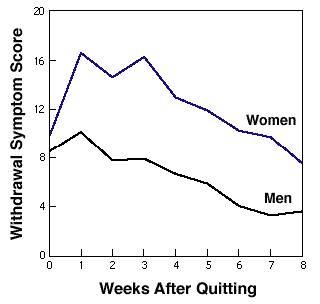Women’s Dependence on Smoking Affected By Something in Addition to Nicotine
Download PDF Version What is PDF?
Neil Swan
Neil Swan is a Staff Writer for NIDA NOTES.
Source: NIDA NOTES, Vol. 12, No. 3, May/June, 1997
Public Domain
Table of Contents (TOC)
Article: Women’s Dependence on Smoking Affected By Something in Addition to NicotineReferences
A number of studies have shown that women find it more difficult than do men to quit smoking cigarettes. This is especially evident in studies of nicotine replacement therapies that use nicotine patches or nicotine gum. Now two separate NIDA-funded studies examining gender differences related to smoking suggest that something in addition to nicotine is involved in women’s dependence on smoking tobacco.
"It appears that, compared to men, women may smoke less for nicotine and more for nonnicotine effects of smoking," says Dr. Kenneth A. Perkins, a psychologist at the University of Pittsburgh Medical Center. These nonnicotine influences might include nondrug-induced sensory effects like seeing and smelling tobacco smoke, conditioned responses to these smoke stimuli, or social pleasures involved in smoking rituals, he suggests.
 For example, one observer has noted that smokers may exhibit
gender differences in the way they gather outside buildings
to smoke, Dr. Perkins says. Male smokers tend to be loners;
females tend to gather in social groups. These behaviors
may indicate critical gender-based differences relating
to tobacco smoking that may have little to do with nicotine,
observers theorize. Dr. Perkins calls these nonnicotine
influences "external stimuli."
For example, one observer has noted that smokers may exhibit
gender differences in the way they gather outside buildings
to smoke, Dr. Perkins says. Male smokers tend to be loners;
females tend to gather in social groups. These behaviors
may indicate critical gender-based differences relating
to tobacco smoking that may have little to do with nicotine,
observers theorize. Dr. Perkins calls these nonnicotine
influences "external stimuli."
If further research supports this view of gender differences in external and behavioral influences related to smoking, says Dr. Perkins, it will be important to revise smoking cessation treatments for women trying to quit. This would mean tailoring therapy for women to increase behavioral support and rely less on nicotine replacement.
Dr. Perkins reviewed scores of studies of smoking and its addictive properties and smoking cessation programs. He found that these epidemiological and clinical studies consistently show that while smoking is declining among Americans, it is not decreasing as rapidly among women as among men. If present trends continue, women smokers will outnumber men by the next decade, says Dr. Perkins. The research suggests that this is at least partly because of the greater difficulty women have in quitting. Women in the studies tend to be less successful in smoking cessation trials, especially those using nicotine replacement therapy.
Withdrawal Is Different for Women- Appetite, Craving Greater Than Men’s

Women using nicotine gum therapy to quit smoking reported greater withdrawal symptoms than men did. The Withdrawal Symptom Score was calculated from self reports of the degree to which study participants experienced symptoms such as craving for a cigarette, irritability, anxiety and tenseness, and excessive hunger. A high score represented greater symptoms.
Lower cessation rates for women could be expected if women smoked more cigarettes or inhaled more nicotine than did men. Both are indicative of nicotine dependence, and smokers who are more strongly nicotine-dependent often have greater difficulty quitting. But just the opposite appears to be the case, says Dr. Perkins. Women tend to smoke fewer cigarettes per day, to smoke brands with lower nicotine yields, and to be less likely to inhale deeply, compared to men, according to his research review. Thus, evidence indicates women smokers are less, not more, nicotine-dependent than are men.
Further support for the notion of additional, nonnicotine addiction factors comes from a study of gender differences in the effects of different doses of nicotine gum on tobacco withdrawal symptoms. Dr. Dorothy Hatsukami, a psychiatry professor at the University of Minnesota, found that nicotine gum did not work as well to ease withdrawal symptoms for women trying to quit smoking as it did for men trying to quit. As in Dr. Perkins’ review, her results seemed contrary to expectations. If women are more sensitive to or dependent on the effects of nicotine than are men, as their lower smoking cessation rates would suggest, then women should be more responsive than are men to nicotine replacement, she reasoned. But this was not shown in her data, which paralleled Dr. Perkins’ findings. Women were less sensitive to the effects of nicotine, she says.
 The lower cessation success with nicotine replacements
in women compared to men may in part be attributed to this
reduced effectiveness of the replacement therapy in relieving
nicotine withdrawal symptoms. It also may indicate that
something else is involved besides nicotine dependence,
says Dr. Hatsukami. Like Dr. Perkins, she concluded that
women may be more affected by other aspects of smoking.
The lower cessation success with nicotine replacements
in women compared to men may in part be attributed to this
reduced effectiveness of the replacement therapy in relieving
nicotine withdrawal symptoms. It also may indicate that
something else is involved besides nicotine dependence,
says Dr. Hatsukami. Like Dr. Perkins, she concluded that
women may be more affected by other aspects of smoking.
What is the "something else?" In his review, Dr. Perkins examines alternative possibilities such as gender variations related to body weight or physiological effects of the 4,000 compounds found in cigarettes in addition to nicotine. He finds no strong evidence to support these or other alternative explanations for gender differences in responses to smoking or attempts to quit smoking, leading to his speculation on the role of nondrug, or external, factors.
One answer might lie in psychophysiology studies that compare men’s and women’s abilities to detect changes within their bodies, such as heart-beat rate fluctuations, explains Dr. Perkins. Women are consistently less able than are men to detect changes in heart rate when no external clues are provided, according to a research review published in 1995 by Southern Methodist University scientists. But this gender difference narrows significantly when subjects are provided with an external context, or clue, for the internal changes, such as viewing a horror film.
Thus, external stimuli appear to be more important to women than to men. It can be theorized, then, that women may be less responsive to internal stimuli such as nicotine and more responsive to external stimuli such as the sight and smell of tobacco and its smoke, he says.
 Dr. Perkins emphasizes that it is wrong to conclude that
nicotine is not important in reinforcing tobacco smoking
among women. Women clearly experience nicotine withdrawal
symptoms, he says. "The point is that there may be relatively
subtle - but very important - differences in the sources
of reinforcement [reward] that tobacco smoking provides
to women relative to men," he says.
Dr. Perkins emphasizes that it is wrong to conclude that
nicotine is not important in reinforcing tobacco smoking
among women. Women clearly experience nicotine withdrawal
symptoms, he says. "The point is that there may be relatively
subtle - but very important - differences in the sources
of reinforcement [reward] that tobacco smoking provides
to women relative to men," he says.
Some observers have speculated on the role of external influences in gender differences related to the use of other abused drugs. Research with users of cocaine, heroin, and other drugs points up the significance of external drug-craving "cues" such as persons, activities, or locations associated with prior drug use. Are there critical gender differences in responses to these powerful craving cues?
More research is essential, says Dr. Perkins. For tobacco, more study is called for because studies of nonnicotine reinforcement may help develop more effective smoking cessation therapies for women, he says.
Hatsukami, D.; Skoog, K.; Allen, S.; and Bliss, R. Gender and the effects of different doses of nicotine gum on tobacco withdrawal symptoms. Experimental and Clinical Psychopharmacology 3(2):163-173, 1995.
Perkins, K.A. Sex differences in nicotine versus nonnicotine reinforcement as determinants of tobacco smoking. Experimental and Clinical Psychopharmacology 4(2):166-177, 1996.
Pennebaker, J.W., and Roberts, T.A. Toward a his and hers theory of emotion: Gender differences in visceral perception. Journal of Social and Clinical Psychology 11:199-212, 1992.


